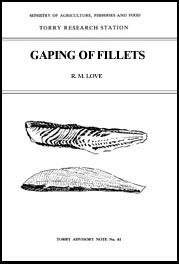Contents Index

Accompanying Notes
Table of Contents
R. M. LOYE
MINISTRY OF AGRICULTURE, FISHERIES AND FOOD
TORRY RESEARCH STATION
TORRY ADVISORY NOTE No. 61
Crown copyright material is reproduced with the permission of the Controller of Her Majesty's Stationery Office.
This electronic document has been scanned using optical character recognition (OCR) software and careful manual recorrection. Even if the quality of digitalisation is high, the FAO declines all responsibility for any discrepancies that may exist between the present document and its original printed version.
Explains what gaping is, when and how it occurs, and what can be done to reduce its occurrence in both fresh, unfrozen fish and thawed, frozen white fish. Discusses the effects on gaping of species, size, the condition of the fish, poor handling, rigor, the time and temperature of stowage, and freezing. Advises on how to reduce gaping particularly in the context of handling on board freezer trawlers. In addition to the other Notes referenced in the text, it should be read in conjunction with Notes 34, 67 and 90.
(FAO in partnership with Support unit for International Fisheries and Aquatic Research, SIFAR, 2001).
Introduction
What is meant by gaping?
What holds the fillet together?
When does gaping occur?
Causes of gaping
Do freezing and
cold storage affect gaping?
How to reduce gaping
Contents Index